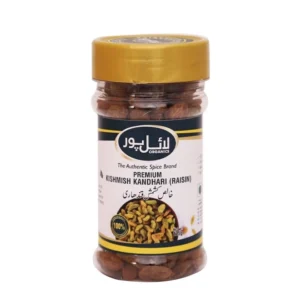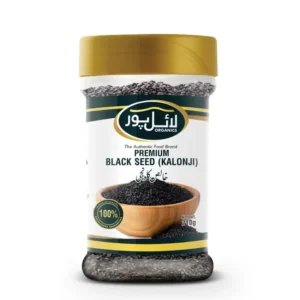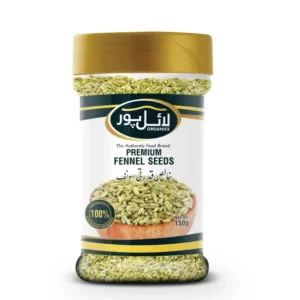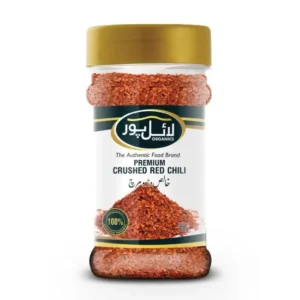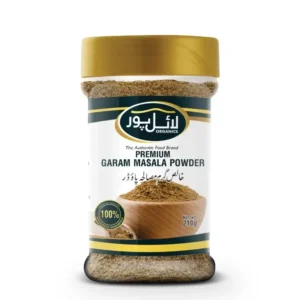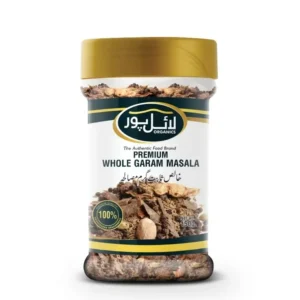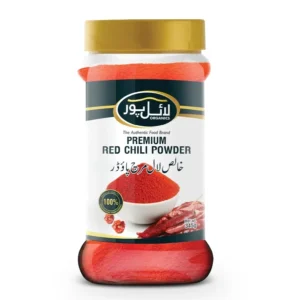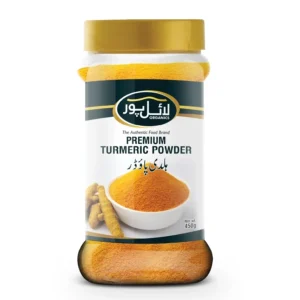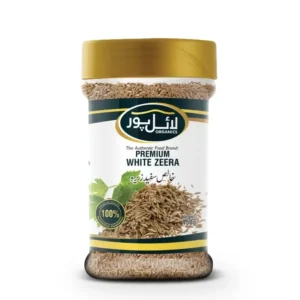Lyallpur Organics Premium Kishmish (Raisins) – 100% Natural Organic & Pure | Rich in Nutrients & Sweet Flavour | Perfect for Snacking, Baking & Cooking
Kishmish is the Persian word for raisins. Raisins are dried grapes, often enjoyed as a sweet snack or used in cooking and baking. They are small, sweet, and packed with nutrients, making them a popular ingredient in many cuisines worldwide.
History and Origin of Kishmish
The history of kishmish, or raisins, dates back thousands of years, likely discovered accidentally when grapes were left to dry in the sun. The earliest known mention of dried grapes comes from ancient Persia (modern-day Iran) and Egypt, where they were valued as a food source.
Ancient Persia: Kishmish was swell-famous in Persian cuisine, used in cooking, baking, and as a sweetener.
Ancient Egypt: Raisins were a favorite among the pharaohs, found in tombs, indicating their importance. Egyptians also used raisins in their cooking and offerings.
Raisins became popular in Greece and Rome after being introduced by Persian traders. They were used in various dishes. During the Middle Ages, Spanish and Italian merchants spread raisins throughout Europe, where they became a common ingredient.
Finally, in the late 19th century, raisins gained popularity in the United States, particularly California, due to their ideal climate for growing grapes and producing raisins. Today, California is one of the largest producers of raisins in the world.
Ancient Persia: Kishmish was swell-famous in Persian cuisine, used in cooking, baking, and as a sweetener.
Ancient Egypt: Raisins were a favorite among the pharaohs, found in tombs, indicating their importance. Egyptians also used raisins in their cooking and offerings.
Raisins became popular in Greece and Rome after being introduced by Persian traders. They were used in various dishes. During the Middle Ages, Spanish and Italian merchants spread raisins throughout Europe, where they became a common ingredient.
Finally, in the late 19th century, raisins gained popularity in the United States, particularly California, due to their ideal climate for growing grapes and producing raisins. Today, California is one of the largest producers of raisins in the world.
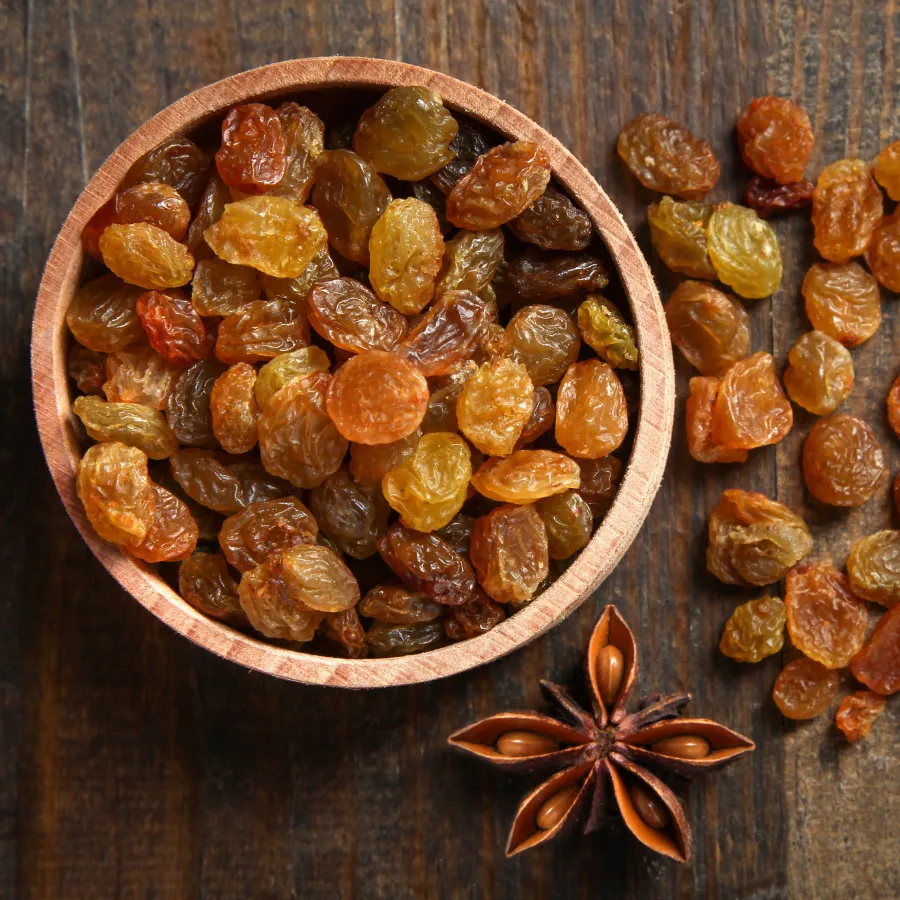
Top Kishmish (Raisins) Products by Lyallpur Organics
Benefits of Raisins (Kishmish)

- Rich in vitamins such as B1, B2, B6, and B5
Contains essential minerals like iron, potassium, calcium, magnesium, and zinc - High in dietary fiber, aiding digestion and promoting bowel regularity
- Packed with antioxidants like flavonoids, phenols, and polyphenols
- Contains natural sugars like glucose and fructose for a quick energy boost
- Improves digestion and prevents constipation Provides a quick source of energy, ideal for athletes and active individuals
- Enhances iron levels, preventing anemia Promotes bone health with calcium and boron, preventing osteoporosis
- Supports heart health by regulating blood pressure and reducing bad cholesterol levels
- Aids in weight management by helping you feel full longer
- Improves skin health by fighting free radicals and reducing signs of aging
- Boosts the immune system with vitamins and antioxidants
- Supports eye health, reducing the risk of age-related macular degeneration and cataracts
- Promotes dental health by protecting teeth against cavities and decay
Nutritional Composition of Kishmish per 100g
Macronutrients:
Calories: 299 kcal, Calories: 299 kcal, Total Fat: 0.5 g, Cholesterol: 0 mg, Sodium: 11 mg, Total Carbohydrates: 79 g, Protein: 3.1g
Vitamins and Minerals:
Vitamin C: 2.3 mg
Vitamin K: 3.5 µg
Thiamin (B1): 0.106 mg
Riboflavin (B2): 0.125 mg
Niacin (B3): 0.766 mg
Vitamin B6: 0.174 mg
Folate: 5 µg
Calcium: 50 mg
Iron: 1.88 mg
Magnesium: 32 mg
Phosphorus: 101 mg
Potassium: 749 mg
Zinc: 0.22 mg
Copper: 0.318 mg
Manganese: 0.299 mg
Vitamin C: 2.3 mg
Vitamin K: 3.5 µg
Thiamin (B1): 0.106 mg
Riboflavin (B2): 0.125 mg
Niacin (B3): 0.766 mg
Vitamin B6: 0.174 mg
Folate: 5 µg
Calcium: 50 mg
Iron: 1.88 mg
Magnesium: 32 mg
Phosphorus: 101 mg
Potassium: 749 mg
Zinc: 0.22 mg
Copper: 0.318 mg
Manganese: 0.299 mg

Different Types of Dried Grapes (Raisins)
Location-Based Variations
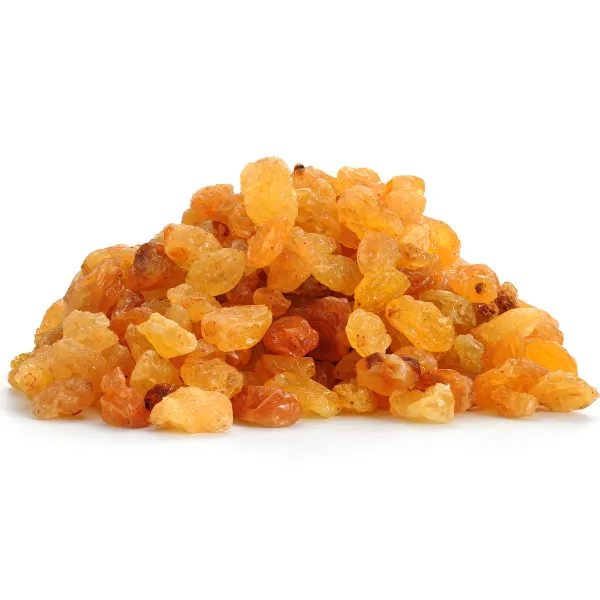
Kandahari
Kandahari Kishmish is from the Kandahar region, known for its high-quality dried grapes. Often associated with black or green raisins, prized for their rich, deep flavor that enhances traditional dishes and sweets.

Sundarkhani
Sundarkhani Kishmish is known for their sweetness and size, similar to golden raisins or sultanas. Light color, large, plump shape, and a delightful balance of sweetness and tanginess. Popular for incorporating into desserts and baked goods.
Color-Based Variations

Golden Raisins
Made from green grapes and treated with sulfur dioxide to retain their light color, it gives them a sweet and spicy flavor. Popular in baking, cooking, trail mixes, and cookies.
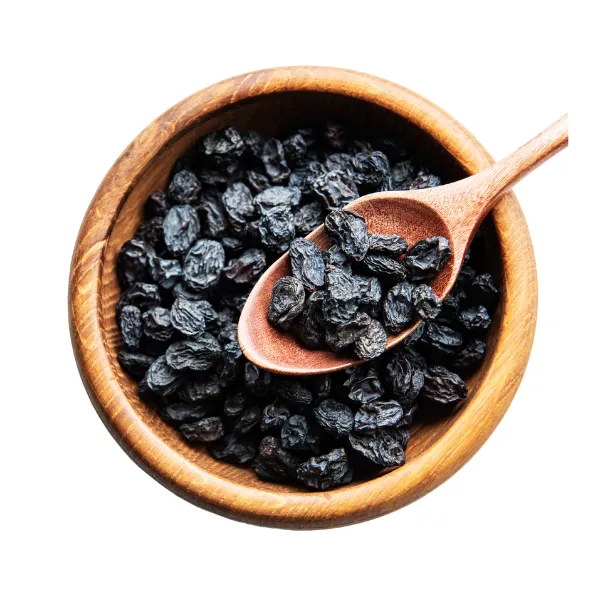
Black Raisins
Made from dark-colored grapes, dried naturally under the sun for a deep, rich flavor and chewy texture. Popular for snacking and including in recipes.

Green Kishmish
Made from green grapes and naturally dried to retain their greenish hue, with a mildly sweet flavor. Common in Middle Eastern and South Asian cuisines.
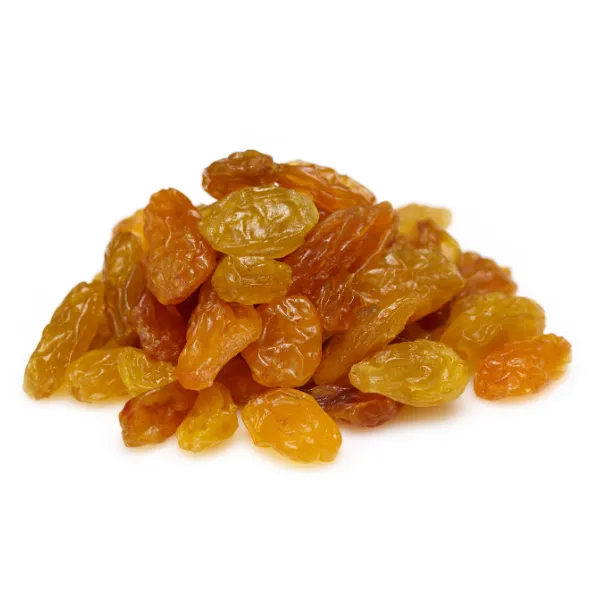
Sultanas
Made from seedless white grapes, known for their light color, small size, and sweet, juicy flavor. Popular for adding sweetness and moisture to desserts and cereals.

Flame Raisins
A type of kishmish made from flame seedless grapes, known for their large size, plump texture, and delightful balance of sweetness with a hint of tartness.
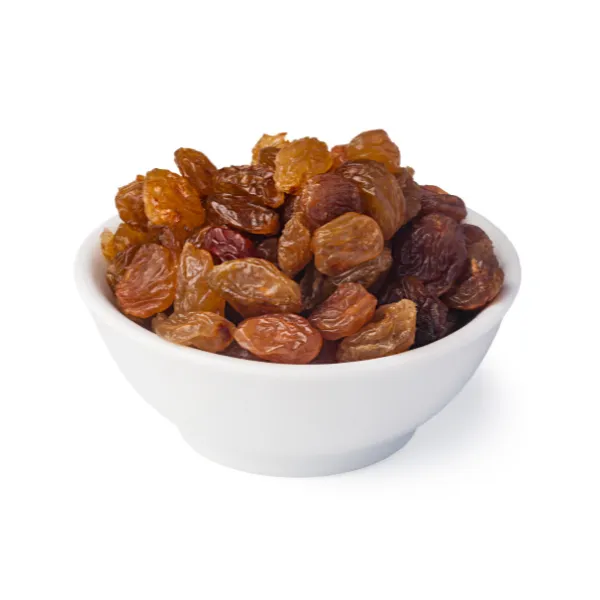
Monukka Raisins
This type of kishmish is known for its large size, dark color, chewy texture, and slightly sweet flavor. Popular for both healthy snacking and gourmet dishes.
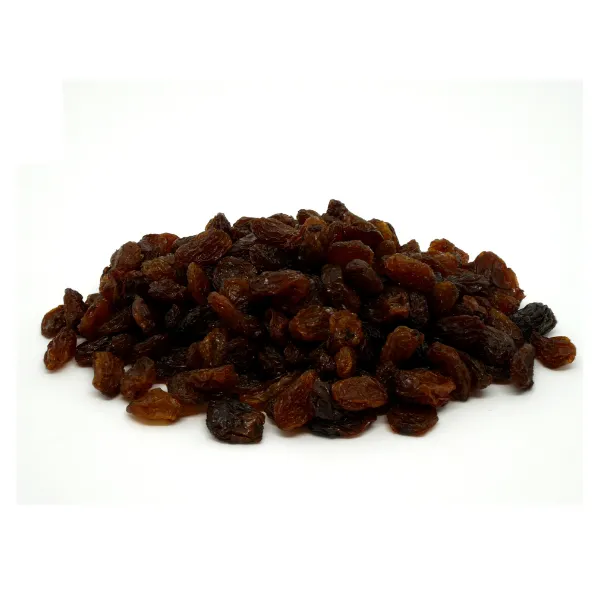
Currants
Small, dark-colored dried grapes made from Black Corinth grapes. Quite smaller than other raisins with an intense flavor, they are popular in baking, especially cakes and pastries.
Different Forms and Uses of Kishmish

Raisin Bread
Raisin bread contains whole raisins in the dough. It is slightly sweet and often enjoyed toasted with butter or as part of a sandwich. It is a popular choice for breakfast or a snack.
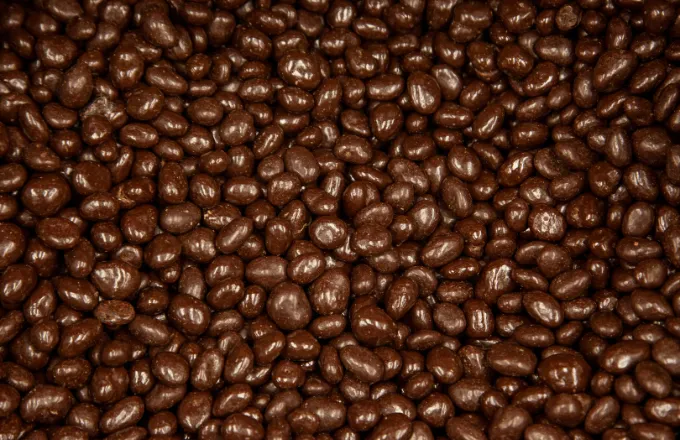
Chocolate-Covered
A delightful treat combining sweet raisins and rich milk, dark or white chocolate, enjoyed alone or in trail mixes.
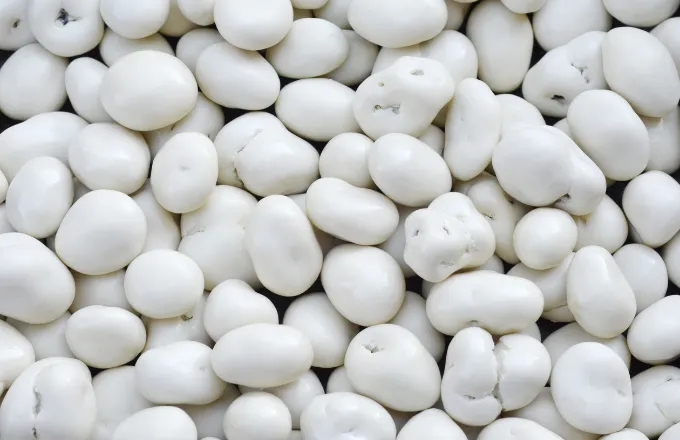
Yogurt-Covered
A tasty snack featuring whole raisins coated in tangy yogurt for a delightful contrast of flavors and a nutritious option.
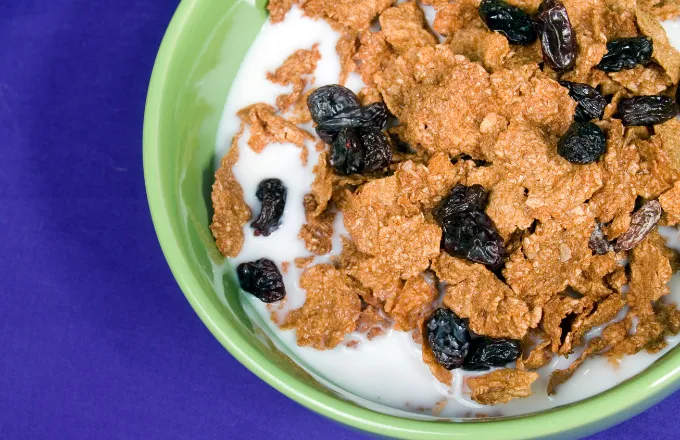
Raisin Bran
A popular breakfast cereal combining crunchy bran flakes with sweet raisins, providing a nutritious start to the day with fiber and essential nutrients.

Raisin Paste
Made from ground raisins into a smooth, thick paste, used as a natural sweetener in baking, cooking, and making sauces. It can also be spread on bread or filled in pastries and cookies.

Raisin Juice
Extracted and concentrated juice from raisins, used as a natural sweetener in various applications, including beverages, baked goods, and sauces.
Raisins (Dried Grapes) in Cooking
They are a versatile ingredient in cooking, adding natural sweetness, texture, and flavor to various dishes. They can be used in sweet and savory recipes. It makes raisins in many culinary traditions, including those in the subcontinent and Pakistan.
Subcontinental and Pakistani Recipes
Kheer (Rice Pudding): Kheer is a traditional Pakistani and Indian dessert made with rice, milk, sugar, and cardamom.
Sheer Khurma: Sheer Khurma is a delicious dessert made during Eid celebrations. It consists of vermicelli cooked in milk and flavored with cardamom, saffron, and rose water.
Halwa: Various types of halwa, such as suji (semolina) halwa or gajar (carrot) halwa, use kishmish for added sweetness and texture.
Gulab Jamun: Gulab jamun is a deep-fried dough ball soaked in sweet syrup. Kishmish is stuffed inside the dough balls before frying.
Pulao: Pulao is a less spicy rice dish compared to biryani. Raisins are commonly added to pulao.
Kofta Curry: Kofta curry consists of meatballs cooked in a rich, spicy gravy.
Chutneys and Sauces: Kishmish is also used in chutneys and sauces to add sweetness and depth of flavor.
Salads: In salads, raisins are added. It works well in both fruit and vegetable salads.
Sheer Khurma: Sheer Khurma is a delicious dessert made during Eid celebrations. It consists of vermicelli cooked in milk and flavored with cardamom, saffron, and rose water.
Halwa: Various types of halwa, such as suji (semolina) halwa or gajar (carrot) halwa, use kishmish for added sweetness and texture.
Gulab Jamun: Gulab jamun is a deep-fried dough ball soaked in sweet syrup. Kishmish is stuffed inside the dough balls before frying.
Pulao: Pulao is a less spicy rice dish compared to biryani. Raisins are commonly added to pulao.
Kofta Curry: Kofta curry consists of meatballs cooked in a rich, spicy gravy.
Chutneys and Sauces: Kishmish is also used in chutneys and sauces to add sweetness and depth of flavor.
Salads: In salads, raisins are added. It works well in both fruit and vegetable salads.

Buying and Storing Kishmish
Look for plump, fleshy raisins with a consistent color, whether golden, black, or green. Avoid dry or sugary-coated raisins.
Raisins should be soft and slightly chewy. Avoid hard or excessively dry raisins.
Raisins should be soft and slightly chewy. Avoid hard or excessively dry raisins.

Ensure airtight packaging is free from tears or punctures, and check the expiration date for freshness.
Consider organic raisins if you prefer to be grown without synthetic pesticides or fertilizers.
Buying in bulk can be economical, but it ensures a high turnover for freshness. Pre-packaged raisins are convenient and often come with a freshness seal.
Transfer raisins to an airtight container after opening to prevent moisture loss.
Store in a cool, dark, dry place to maintain freshness and flavor.
For long-term storage, refrigerate raisins in an airtight container to extend shelf life by up to a year.
Freeze raisins in a freezer-safe bag or container for up to two years. Soften at room temperature before use.
Periodically check for signs of spoilage like an off smell, mold, or hardness. Discard any spoiled raisins.
Consider organic raisins if you prefer to be grown without synthetic pesticides or fertilizers.
Buying in bulk can be economical, but it ensures a high turnover for freshness. Pre-packaged raisins are convenient and often come with a freshness seal.
Transfer raisins to an airtight container after opening to prevent moisture loss.
Store in a cool, dark, dry place to maintain freshness and flavor.
For long-term storage, refrigerate raisins in an airtight container to extend shelf life by up to a year.
Freeze raisins in a freezer-safe bag or container for up to two years. Soften at room temperature before use.
Periodically check for signs of spoilage like an off smell, mold, or hardness. Discard any spoiled raisins.
Other Top Products By Lyallpur Organics
Cultivation of Raisins
Grapes can be dried using various methods:
Sun Drying: Grapes are laid out on drying racks or paper trays in the sun for several days until they dehydrate.
Shade Drying: Grapes are dried in a shaded area to prevent excessive heat and maintain color.
Mechanical Drying: Grapes are dried in controlled environments using dehydrators, allowing for a faster and more consistent process.
Once dried, raisins are cleaned to remove any debris or stems. They are then sorted based on size and quality, with the best ones selected for packaging.
Grapes suitable for raisin production include Thompson Seedless, Black Corinth, and Sultana, which were chosen for sweetness. They are seedless and dry.

Grapes thrive in warm, dry climates with ample sunlight, well-drained soil, good fertility, and a slightly acidic to neutral pH.
Regular watering is essential during the growing season; avoid overwatering. Fertilizers rich in nitrogen, phosphorus, and potassium promote healthy growth.
Grapes are harvested in late summer to early autumn when they reach optimal sweetness. Harvest timing is crucial for the best quality raisins.
Regular watering is essential during the growing season; avoid overwatering. Fertilizers rich in nitrogen, phosphorus, and potassium promote healthy growth.
Grapes are harvested in late summer to early autumn when they reach optimal sweetness. Harvest timing is crucial for the best quality raisins.


